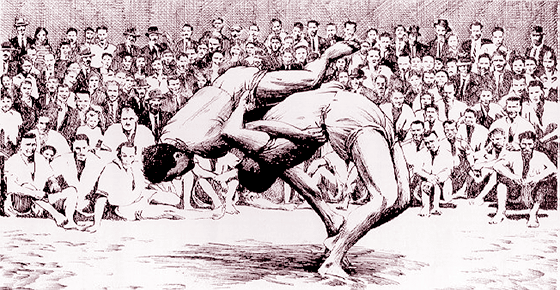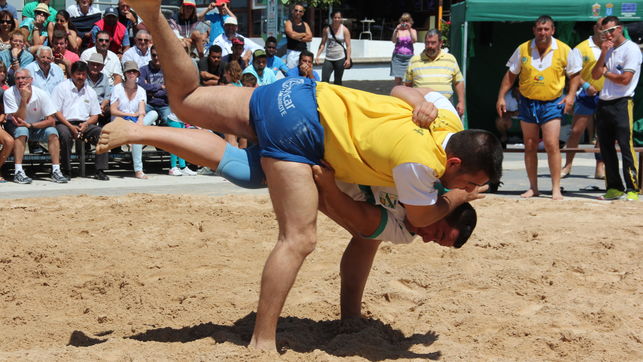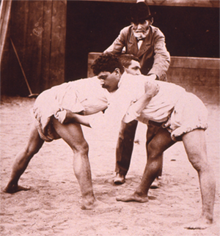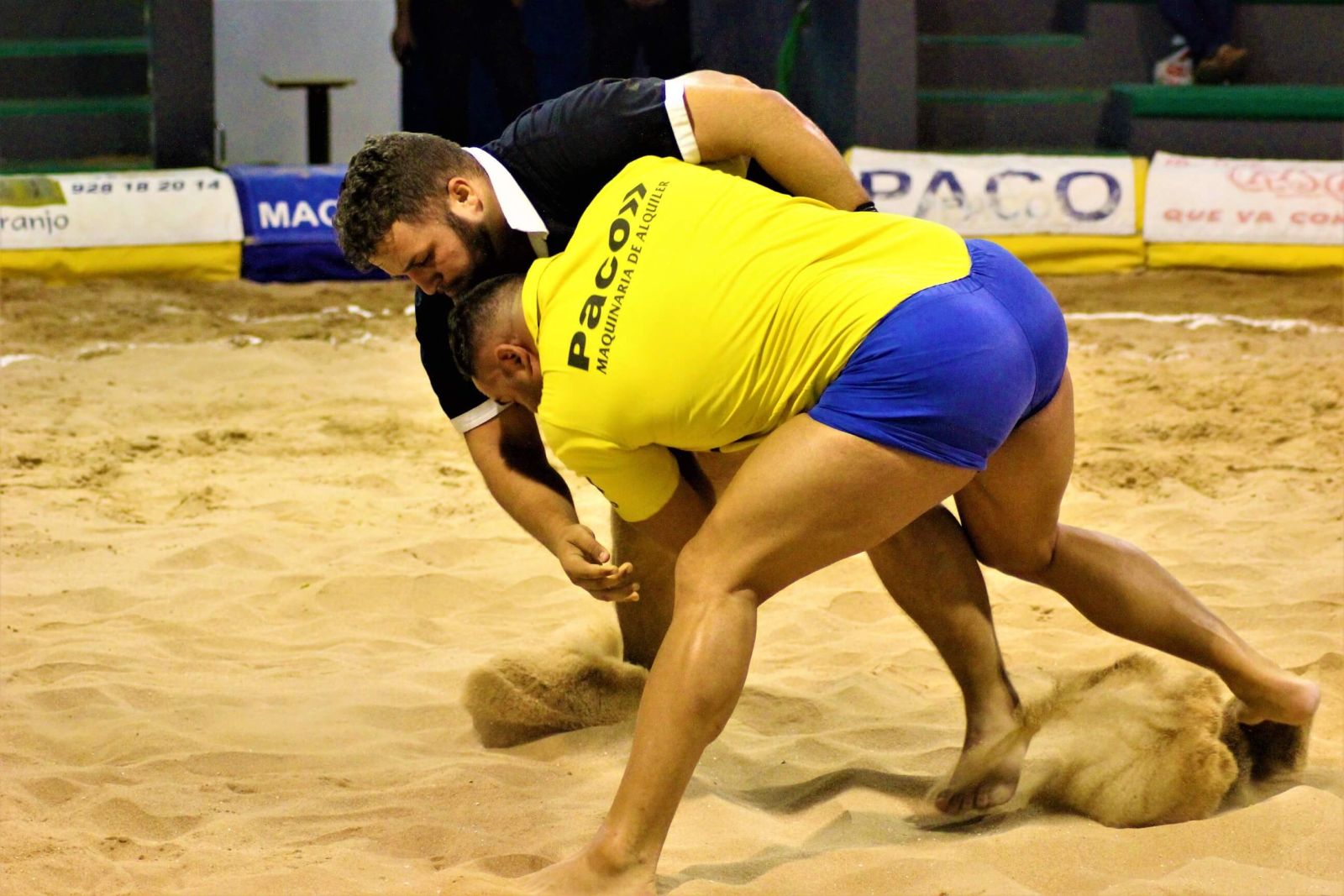A sport typical of the Canary Islands, the Canarian Wrestling has been kept alive over the centuries thanks to oral transmission. The ancient Canarians used wrestling to perform religious rituals which, nowadays, are performed exclusively for sporting purposes and in places specifically designed for it.
Thanks to the geographical location of the islands, it has contributed to the influence of different peoples who, in one way or another, have left their mark on the islands.
One example of this influence is the different games played on the archipelago, which have become a cultural heritage that has been maintained by the ancient inhabitants of the islands thanks largely to written sources. Some examples are the juego del palo (literally, game of stick), salto del pastor (literally shepherd's jump), etc.
However, among all these games, today we come to talk about Canarian Wrestling, how it arose, how it evolved or how its rules are so that you can better understand everything about the vernacular sport.
What is Canarian Wrestling?
Canarian Wrestling is the most traditional sport on the islands. The chronicles of the conquest echoed the Canarian Wrestling by the islanders, which they passed on from generation to generation.
According to these chronicles, the fights were carried out to resolve conflicts over the owning of land or other issues. Nobility, respect and team spirit are elements that should always prevail in this type of practice.
Likewise, Canarian Wrestling has always been regarded as a sport for large and rough men. However, to be a wrestler you do not need to meet these requirements, it rewards agility more than strength in this sport, especially to see what the opponent's weaknesses are and use them against him to knock him down.
The fights takes place in rounds that bring together the opponents of two teams that are eliminated as they lose in the fights.

History of Canarian Wrestling
The first Canarian fighting techniques were recorded for the first time in the year 1420, and the referees who were known as "men of honour" were also appointed.
The origin of this practice has provoked a great debate over the years. The most widespread theory about the origins of Canarian Wrestling is that it comes from North Africa, via the Berbers.
A fact in favour of this theory is that there are a series of wrestlings exactly like the Canarian Wrestling in North Africa and that they fully coincide with the fights practiced in the past. Experts in the field divide the Canarian Wrestling into three periods.
Historical stage
The most primitive wrestling is that of the 15th century which is characterized by:
- Techniques similar to the current ones.
- The development of the challenges, the honorability of the wrestling and the way of grabbing.
- Every confrontation is a running fight.
- They were smeared in lard to make it difficult for the opponent to grip.
- The figure of the "man of honor" begins to gain importance.
Folkloric stage
We take a leap forward to the 19th century when the Canarian Wrestling begins establishing in Canarian culture, considering it as another example of folklore and tradition.
This is the time when wrestling began to develop for all the peoples of the islands, overcoming the obstacles imposed on them by the bourgeoisie of the time, who branded the Canarian Wrestling as something despicable, vulgar and anachronistic.
- There were no written rules, the rules were established before the fight.
- The teams were made according to villages or regions, and there were no fixed teams or fighters in a team.
- The fights took place at festivals or events of great importance in the villages.
- Different forms of grip between islands. For example, in Tenerife they fought hand down.
Institutional stage
Canarian Wrestling evolved to a sport. In the 1940's, the Canarian Wrestling Federation was created, with provincial headquarters, totally dependent on the Spanish Wrestling Federation.
In 1947 the first two independent provincial federations were created.
- Los comisionados dieron paso a los árbitros.
- Serán 12 los luchadores que habrá por equipo.
- El tipo de agarrada de lucha canaria se establece a mano abajo en todas las islas.
- Las luchadas se desarrollarán entre equipos federados, formándose competiciones reguladas como las insulares, provinciales y regionales.
- The commissioners gave way to the referees.
- 12 wrestlers per team.
- The type of Canarian Wrestling grip is set down by hand on all the islands.
- Fights between federated teams, with regulated competitions such as island, provincial and regional.
- Canarian Wrestling is today a very widespread sport, with an independent Canarian Federation, based on each of the islands and with unique rules.

Rules of Canarian Wrestling
The rules that began to be used nowadays appeared in 1870, but it was not until 1940 that the federations were formed, unifying the regulations for the entire archipelago.
However, over the years these rules have undergone various modifications until they became what they are today.
- The duration of the fight is 3 minutes. In the all against all mode, the duration is 90 minutes.
- The only person who can interrupt the fight is the referee, the time in which the fight is stopped being discounted. During this time, no wrestler can leave the ground, whoever does so will be considered a loser.
- The fall is valid when one of the two wrestlers touches the sand with any part of the body other than his feet.
- In Canarian wrestling, if the fall is simultaneous, the referee may whistle "revolt" (fight again).
- The fall that occurs when one wrestler takes the other by the hand and forces him to touch the ground is not valid.
- The fall is valid when the wrestler falls on the inside of the line, also being valid if he or she touches the outside of the line. However, if the first wrestler falls outside the line, the line is broken.
Within the rules we can also distinguish erroneous positions such as the following:
- Not positioning well at the start of the grab.
- Having the hands out at the moment of immobilization.
- The grip is always performed with the opponent's left hand and right hand, a sudden change of hand is an infringement.
- When any action endangers any joint of the opponent.
- Having the head on the opponent's clavicle or chest.
- To perform a sudden and very violent jerk to make the opponent drop his underwear.
- Disrespecting the referee or the opponent.
How is Canarian Wrestling practiced?
Canarian Wrestling is practiced through some techniques that the wrestler uses to knock down his opponent to the point that he or she touches the sand with some part of his body.
On many occasions, the wrestler uses more than one technique to knock down his opponent, so he or she usually performs a combination of these.
Likewise, in order to understand better how the game is played, we can distinguish 3 types of mañas (techniques) within Canarian Wrestling.
Grabbing techniques
These are techniques that consist of holding on to the opponent as much as possible to try to destabilize and lifting him or her by making him lose his balance.
Blocking techniques
They consist of immobilizing some part of the opponent's body, with the arms, with the legs, to knock down and take him or her to the sand without having to go to extremes such as dislocation or strangulation.
Diverting techniques
Techniques that seek to deflect the action of the opponent by moving the body and with the strength of it, knock him or her down on the sand.

Famous Canarian wrestlers
Canarian Wrestling cannot be fully understood without its great protagonists, the wrestlers. People of great size, tough, but with a nobility and a sportsmanship in the field that is worthy of praise.
Through the years, many wrestlers have fought all over the islands, all of them with a capital importance in the consolidation of Canarian Wrestling as a sport that is very much to be considered in the islands.
However, there is a special place for some wrestlers who have managed to be recognised not only on the national scene but also internationally. That is why, we are going to present you, those who are in our opinion, are the 3 most famous wrestlers of Canarian wrestling.
Francis Pérez, el Pollito de la Frontera
One of the most emblematic fighters of the 90s and a legend of the Canarian Wrestling. Born on the island of El Hierro, Francis Pérez became an emblem of the vernacular sport.
His dedication was amazing, as he trained every day of the year for 7 hours and with his 1.96 and 150 kilos he became a real machine to knock down opponents in the Canarian Wrestling of the time. He retired very early in 2007, at the age of 33, due to various back problems.
Juan Espino, el Trota
One of the references of the Canarian Wrestling in recent years. His family has been linked for generations (his grandfather and his father were wrestlers) to this sport. He reached the highest level within Canarian wrestling (A), winning numerous collective and individual titles during his years as a wrestler, making him a legend.
In addition, he has spread the name of the Canary Islands and the Canarian Wrestling all over the world, becoming a reference in other types of wrestling, such as the Korean or the Senegalese, and winning titles.
Juan Barbuzano Martin
He tried his chances in various types of fighting, standing out mainly in Canarian Wrestling. He is considered to be the first great wrestler of the contemporary era.
At the age of 15 he had his first great moment knocking down an already famous wrestler like Miguel Armas three times in a row. From then on, Barbuzano had great performances in the Canarian Wrestling of the 60s and 70s, knocking down 7 of the 12 members of a team, winning championships and individual prizes.
Canarian Wrestling: heritage of the Canary Islands
Canarian sports have been consolidated over the years within the archipelago’s panorama, but none of them have had the repercussion that the Canarian Wrestling has obtained.
Since the 1980's, Canarian Wrestling has been growing as a structure of teams, infrastructures, and money that is invested in it until what it is today, a consolidated sport rooted in Canarian tradition.
However, it is more than just a sport of 12 against 12, where you have to knock down an opponent to win. It is culture, a symbol of Canarian identity, of traditions that have been passed down from generation to generation, becoming part of the cultural heritage of the Canary Islands.
In short, Canarian Wrestling must be cared for, pampered and continue to be transmitted from parents to children with the firm intention of keeping traditions intact and that visitors who come to the islands every year learn a little more about this vernacular sport.
